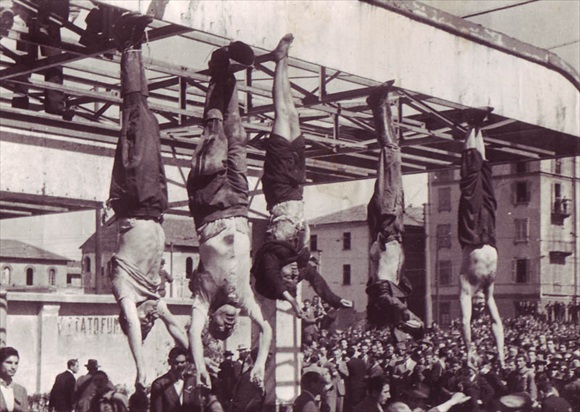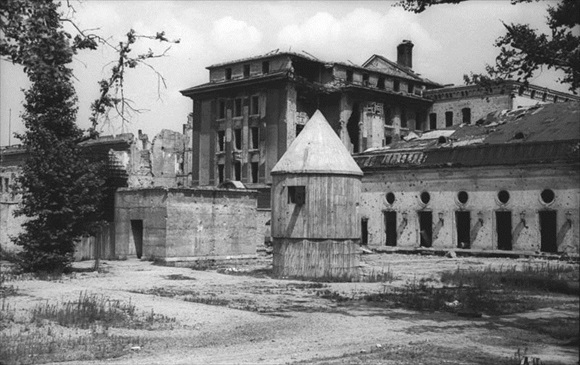ITALIAN PARTISANS CAPTURE MUSSOLINI
Dongo near Lake Como, Northern Italy • April 27, 1945
On this rainy date in 1945, with the Wehrmacht (German armed forces) in Italy in full retreat—indeed, their commanders had signed surrender documents on this date—61-year-old Italian strongman Benito Mussolini was en route to what he hoped would be safe haven in neutral Switzerland and from there to Spain. Il Duce (Italian for “the leader”) was wearing a German noncommissioned officers overcoat and helmet on his bald head as part of a 40-vehicle convoy of mostly German troops heading instead for the Brenner Pass and the safety of Austria. When a truck carrying fuel containers was searched by a group of Italian partisans at Dongo on the northwestern shore of Lake Como, 10-miles from the Swiss frontier, Mussolini’s unmistakable jutting chin gave away the pale figure slouching at the rear as loud cries sounded out: “We have got Mussolini!” A growing crowd of villagers, hearing of Mussolini’s capture, broke into applause.
The next day, Saturday, April 28, Mussolini and his 33-year-old paramour, Claretta Petacci, were pushed into the back seat of a Fiat sedan. When the car later stopped in front of a villa outside the hamlet of Guilino (aka Giulino di Mezzegra), the two prisoners were ordered out, pushed in front of a low stone wall, and pumped full of bullets fired from a French-made submachine gun. Their executioner, a member of the North Italian Committee of National Liberation who went by the name “Colonel Valerio” (real name Walter Audisio), reportedly exclaimed at the time, “I execute the will of the Italian people.” The bodies of Mussolini and Petacci, plus those of fourteen other members of Italy’s Fascist leadership that had been part of the German convoy, were brought to the Northern Italian city of Milan for public display on April 29, then mutilated by enraged onlookers and strung upside down on butchers’ hooks in the Piazzale Loreto (see photo below), the huge open square where fifteen Italian anti-Fascists had been executed by Mussolini’s Blackshirts the year before. The corpses dangled on display at the Piazzale and at the city morgue for a number of days before being buried.
Mussolini’s comrade-in-arms Adolf Hitler, hiding in the clammy recesses of his Fuehrerbunker under the devastated Reich Chancellery garden in Berlin, heard Radio Stockholm’s announcement of the Duce’s death. He likely learned the gory details of Mussolini’s end because he confided to multiple bunker visitors and denizens that he had no intention of letting himself fall victim to a similar fate. The Swedish bulletin reaffirmed his desire to take his own life before it was too late and so prevent his body from being seized and put on public display by his enemies.
To that end, with the Red Army within several hundred yards of the Reich Chancellery and his bunker, Hitler ordered his personal adjutant to obtain as much gasoline as possible. Within minutes of the suicides of Hitler and his wife Eva Braun, their bodies were laid side by side in the sandy soil only yards from the door leading into the garden. Shortly before 4:00 p.m., ten canisters of gasoline were poured over the remains and set on fire. As the men of the funeral party watched the corpses burn, they gave their dead Fuehrer one last Hitler salute and scurried back into the protection of the bunker when Soviet artillery shells started falling into the garden.
Inglorious End of the Dictators: Benito Mussolini and Adolf Hitler
 |
Above: Displayed in the Piazzale Loreto, Milan’s major town square, on April 29, 1945, is the grime-covered corpse of the once-popular Benito Mussolini (second from left) and to the right that of the most prominent of his many mistresses, Claretta Petacci, along with the remains of other executed Fascists, primarily ministers and officials of Mussolini’s Nazi-puppet state Repubblica Sociale Italiana (Italian Social Republic, or simply Salò Republic), plus Petacci’s brother, Marcello. Clad in mechanics overalls, Mussolini had been shot through the forehead 12½ miles from the village of Dongo on Lake Como near the Swiss border late the previous afternoon. His body was taken in a closed van to Milan, the city where Italian Fascism was born in 1919, and dumped in the same spot where the year before Fascist squads had exhibited the bodies of fifteen Milanese civilians (the so-called “Martyrs of Piazzale Loreto”) whom they had killed in retaliation for partisan activity. (The practice of putting political corpses on gruesome display had become almost routine in Fascist Italy.) A howling mob of more than 5,000 people kicked, spat, and even urinated on Mussolini’s remains before his body, with new bullet holes, was hung alongside other bodies upside down by their heels (the ultimate insult) at a gas station. The body on the far right is that of former National Fascist Party Secretary-General Achille Starace, who was executed by anti-Fascist partisans after being shown Mussolini’s corpse and saluting it. The macabre scene was much-photographed and flashed around the world as irrefutable proof that the Italian dictator was dead.
 |
Above: Per instructions, Adolf Hitler’s body and that of his wife and former long-time mistress Eva Braun were carried up the stairs through the bunker’s emergency exit, as seen in this photo facing a tree, doused in gasoline and set alight in the desolated Reich Chancellery garden. Soviet archives record that their burnt remains were recovered and interred in successive locations in Eastern Germany until 1970, when they were again exhumed, cremated, their ashes mixed with pieces of coal and crushed into powder, all of which was thrown into a river near Magdeburg.
Short Political Biography of Benito Mussolini and His Grisly End
![]()

 History buffs, there is good news! The Daily Chronicles of World War II is now available as an ebook for $4.99 on Amazon.com. Containing a year’s worth of dated entries from this website, the ebook brings the story of this tumultuous era to life in a compelling, authoritative, and succinct manner. Featuring inventive navigation aids, the ebook enables readers to instantly move forward or backward by month and date to different dated entries. Simple and elegant! Click
History buffs, there is good news! The Daily Chronicles of World War II is now available as an ebook for $4.99 on Amazon.com. Containing a year’s worth of dated entries from this website, the ebook brings the story of this tumultuous era to life in a compelling, authoritative, and succinct manner. Featuring inventive navigation aids, the ebook enables readers to instantly move forward or backward by month and date to different dated entries. Simple and elegant! Click 











